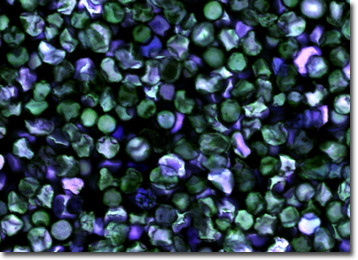 |
 |
 |
|
||||||||||||||||||||||||
 | ||||||||||||||||||||||||
 | ||||||||||||||||||||||||
 | ||||||||||||||||||||||||
Confocal Microscopy Image Gallery
Plant Tissue Autofluorescence Gallery
Cottonwood Pollen
A few weeks each summer, clumps of cottony-coated seeds are shed by several North American tree species belonging to the genus Populus that, as a result, are commonly known as cottonwoods. The trees are dioecious, and only females shed the familiar white fluff, which softly floats through the air for dispersal to new locales.

The cotton can be a nuisance and may clog gutters, air conditioners, and other items, but it is the pollen produced by male cottonwoods that is most problematic for individuals that suffer from allergies. Cottonwoods are solely pollinated by the wind, which requires male trees to produce massive amounts of pollen in order to ensure that it will successfully reach a flower on a female tree. Cottonwood blossoms are long, drooping catkins that emerge before the leaves sprout in the spring.
Cottonwoods grow quickly and are consequently often cultivated as timber. The wood harvested from cottonwoods is strong, but coarse. It is generally not considered suitable for furniture or other uses in which appearance is of significant concern. Accordingly, the wood of the cottonwood tree is most typically employed to produce items such as crating, paper, and pallet boxes. Cottonwood trees are also often grown to serve as shelterbelts, their large root systems being well suited for erosion control.
Contributing Authors
Nathan S. Claxton, Shannon H. Neaves, and Michael W. Davidson - National High Magnetic Field Laboratory, 1800 East Paul Dirac Dr., The Florida State University, Tallahassee, Florida, 32310.
